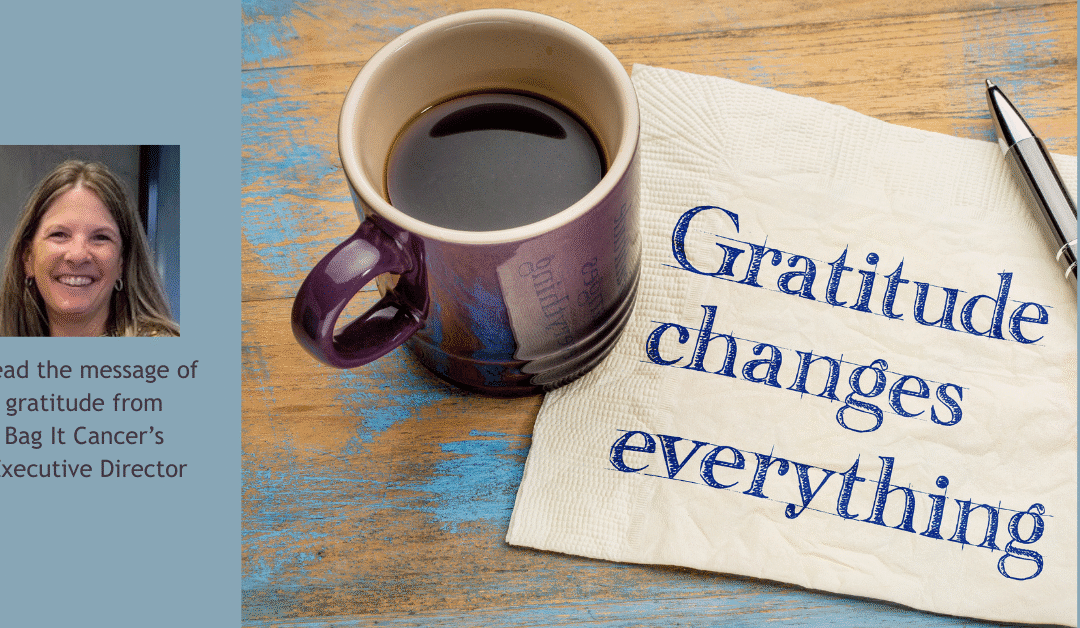
by Bag It Team | Dec 8, 2025 | Educational Articles
By Mindy Griffith, Executive Director
 As this year comes to a close, I find myself thinking about the many hands that have held a Bag It Bag, the conversations sparked by our resources, and the moments when someone realizes they are not facing cancer alone. Those stories stay with me. They remind me why this work matters—and how grateful I am for this community.
As this year comes to a close, I find myself thinking about the many hands that have held a Bag It Bag, the conversations sparked by our resources, and the moments when someone realizes they are not facing cancer alone. Those stories stay with me. They remind me why this work matters—and how grateful I am for this community.
In 2025, we reached more patients and caregivers than ever before, strengthened our relationships with healthcare providers, expanded our offerings with new cancer-specific bags to better meet the diverse needs of those navigating a diagnosis. Each step forward has been made possible because so many of you believe in the importance of empowering people with knowledge, support, and guidance during one of the hardest times in their lives. We truly couldn’t do this without you.
As you look ahead to the new year, we hope you’ll keep Bag It in mind. If someone in your life is facing a new cancer diagnosis—or if you want these resources for yourself—you can order a bag directly from us. And if you’re considering a year-end gift, your support helps ensure we can continue providing these tools to those who need them most. Monthly gifts, no matter the size, make a steady and meaningful impact all year long.
Thank you for being part of the Bag It community and for helping create moments of comfort, clarity, and hope. We look forward to all we can accomplish together in 2026.
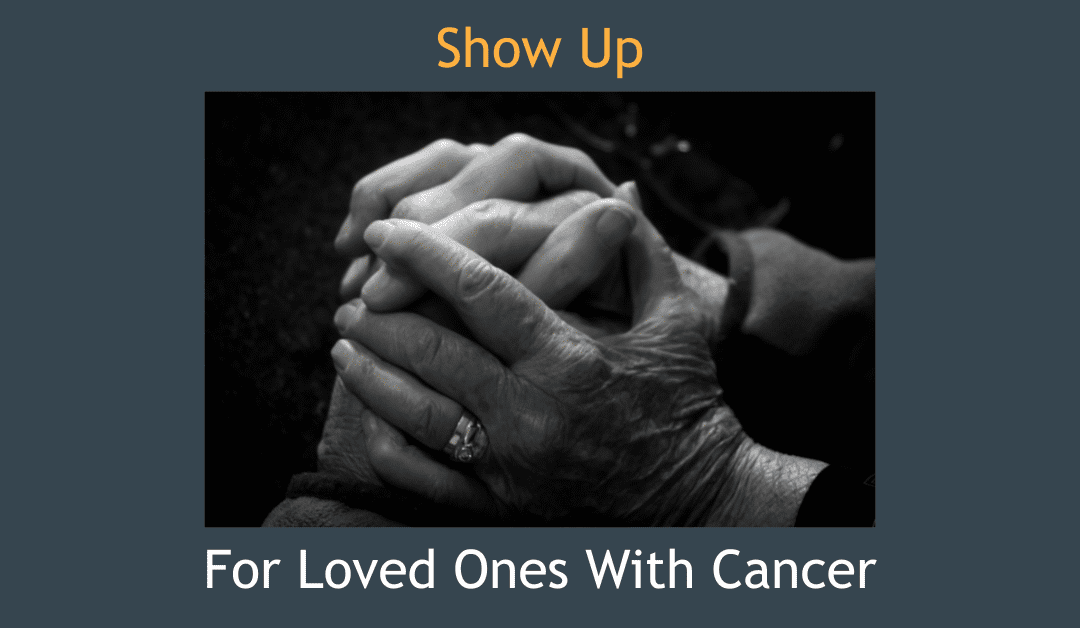
by Bag It Team | Nov 10, 2025 | Educational Articles
By Kerri Reeves, LMSW, Oncology Support Services Manager, Oncology Social Worker , TMC Health Cancer Center
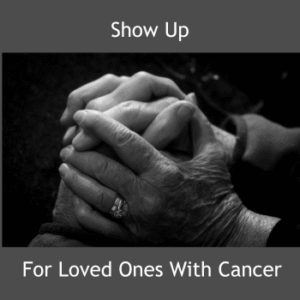 Cancer. It’s a word that can shake the foundation of a person’s world—whether it’s your own diagnosis or that of someone you love. The emotional weight is immense, and the journey ahead can feel uncertain and overwhelming. But one of the most powerful ways we can help is simple: we show up.
Cancer. It’s a word that can shake the foundation of a person’s world—whether it’s your own diagnosis or that of someone you love. The emotional weight is immense, and the journey ahead can feel uncertain and overwhelming. But one of the most powerful ways we can help is simple: we show up.
Research by Evans Webb and colleagues (2021) highlights that cancer patients who receive consistent support from family and friends experience better emotional well-being, are more likely to follow treatment plans, and often have more favorable outcomes. Support matters. And showing up—physically, emotionally, and practically—can make all the difference.
Loved ones respond to a cancer diagnosis in many ways. Some are afraid—afraid of saying the wrong thing, afraid of the disease itself, afraid of the possibility of loss. That fear can lead to distance. Others may respond with overwhelming attention, reaching out constantly in ways that can feel smothering. And some may fade over time, as the initial shock wears off, and life pulls them in other directions.
So how do we support someone with cancer in a meaningful, balanced way?
We show up.
Showing up means being present. It means continuing to be part of their life—not just in the beginning, but throughout the journey. It can be as simple as offering to attend medical appointments and take notes, helping them remember what the doctor said. It might mean driving them to treatments or just sitting beside them in the waiting room.
 Showing up also means keeping life going. Talk to them about your day, share funny stories, laugh about your kids or grandkids—just like you always did. These moments of normalcy can be grounding and comforting.
Showing up also means keeping life going. Talk to them about your day, share funny stories, laugh about your kids or grandkids—just like you always did. These moments of normalcy can be grounding and comforting.
Practical help is another powerful form of support. Cook a meal. Organize a meal train. Help with chores like cleaning, taking out the trash, raking leaves, or walking the dog. These small acts of kindness can ease the burden and remind them they’re not alone.
And don’t stop showing up.
It’s okay to feel scared. It’s okay to feel overwhelmed. Supporting someone through cancer is emotionally taxing, and you may find yourself struggling too. If that happens, ask: who can show up for you?
Oncology social workers are trained to support not only patients but also their loved ones. You’re going through this too, and your feelings are valid. Whether you’re angry, in denial, sad, or even happy—it’s all part of the process. If you find yourself stuck in one of the darker places, it’s time to reach out for help.
Showing up is powerful. It’s healing. It’s human. And it’s something we can all do.
Here are some helpful resources that will guide you in your support journey.
- 16 Ways to Support Someone with Cancer
- Being a Friend to Someone with Cancer
- Appointment buddy or meal planner? 4 ways to support a friend with cancer
- How to Show Up When Your Friend Has Breast Cancer
Reference: Evans Webb, M., Murray, E., Younger, Z. W., Goodfellow, H., & Ross, J. (2021). The Supportive Care Needs of Cancer Patients: a Systematic Review. Journal of cancer education : the official journal of the American Association for Cancer Education, 36(5), 899–908. https://doi.org/10.1007/s13187-020-01941-9
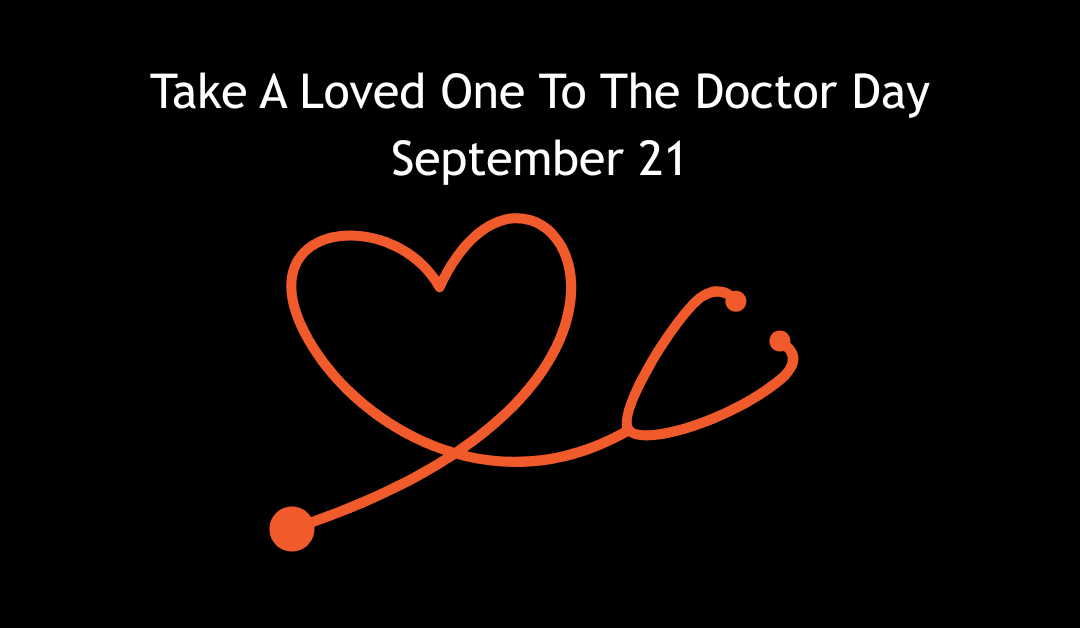
by Bag It Team | Sep 5, 2025 | Educational Articles
 September 21 marks Take a Loved One to the Doctor Day—a national reminder that good health isn’t just a personal responsibility; it’s an important way we can support each other.
September 21 marks Take a Loved One to the Doctor Day—a national reminder that good health isn’t just a personal responsibility; it’s an important way we can support each other.
Whether it’s a parent, spouse, sibling, neighbor or friend, many people put off important medical appointments for reasons ranging from busy schedules to fear of bad news. But preventive care and regular checkups are essential for catching health issues early, managing ongoing conditions, and maintaining overall well-being.
Why This Day Matters
- Early Detection Saves Lives–Many serious health conditions, like cancer, diabetes, and heart disease, have better outcomes when detected early. More about early detection.
- Breaking Down Barriers–Some loved ones may face language, transportation, or cultural barriers to accessing healthcare. Your presence can help bridge those gaps.
- Emotional Support Counts–Going to a doctor’s appointment can feel intimidating. Having someone by your side can ease anxiety and encourage open conversations with healthcare providers.
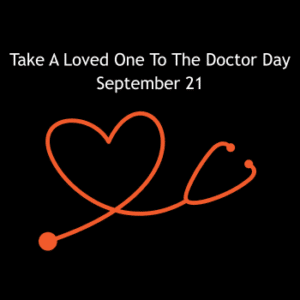 How You Can Participate
How You Can Participate
- Make an Appointment Together–Schedule a checkup for yourself and your loved one on or around September 21.
- Offer a Ride or Company–Even if you’re not the patient, being there for support can make a big difference.
- Help with Questions–Encourage your loved one to write down concerns or symptoms ahead of time so they get the answers they need.
- Celebrate the Step – After the appointment, enjoy a meal or activity together to mark the positive choice.
The Bottom Line
Good health is a gift we can help each other protect. This September 21 (or any day of the year), take the opportunity to show you care—by making sure someone you love gets the care they need. Sometimes, the best way to say “I love you” is with a ride to the doctor.
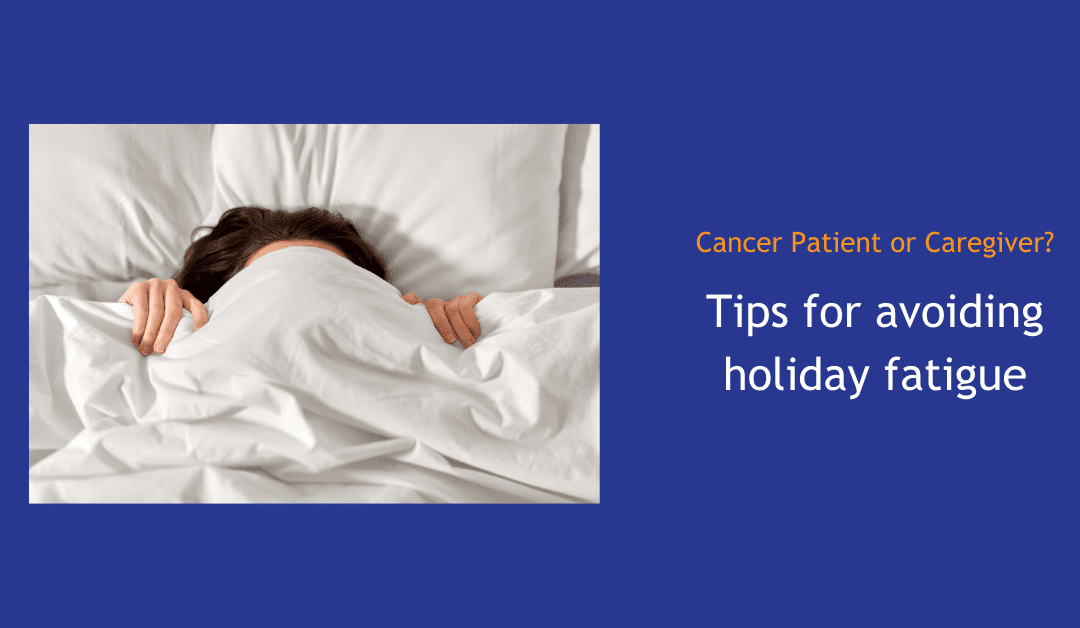
by Bag It Team | Dec 9, 2024 | Educational Articles
The holiday season can be exhausting for anyone, but cancer-related fatigue is a unique challenge. This type of fatigue goes beyond ordinary tiredness. It’s a deep, persistent fatigue or exhaustion that doesn’t improve with rest or sleep, often leaving you feeling unable to carry out your usual activities.
Cancer-related fatigue is a very common issue and can result from several factors, including:
- The cancer itself or other medical conditions.
- Treatments like chemotherapy, radiation, or surgery, and their side effects.
- Medications you’re taking.
- Changes in blood counts.
- Lifestyle factors, such as sleep disruptions, poor nutrition, or inadequate hydration.
- Emotional or mental health struggles, which fatigue can worsen.
You Don’t Have to Endure It Alone
Share your symptoms with your healthcare team so they can identify possible causes and suggest medical and non-medical treatments to help you.
Let loved ones know how you’re feeling—they often want to help but may not know how. Work together to adjust holiday traditions—whether it’s scaling back on celebrations, delegating or sharing tasks like decorating or cooking, or simplifying shopping. Focus on the activities that matter most to you and bring joy.
And yes, naps are absolutely allowed!
Self-Care Strategies for Cancer-Related Fatigue
These tips can help manage fatigue during the holidays and beyond:
- Set priorities. Choose manageable goals, establish routines, and let go of less important tasks. Don’t hesitate to ask for help.
- Balance activity and rest. While conserving energy is essential, staying physically active—even with gentle movement—can boost energy. Ask your healthcare team about safe exercise options.
- Take breaks. Schedule rest or relaxation time during the day, and don’t wait until you’re overtired.
- Improve sleep quality. Follow a bedtime routine to support better rest at night.
- Eat well and stay hydrated. Aim for a balanced diet. Meeting with a registered dietitian or nutritionist can help you to manage treatment side effects, maintain energy, address weight changes, and create tailored meal plans to support overall health and recovery.
- Care for your emotional health. Spend time with people who uplift you, and communicate your feelings—whether happy, sad, or tired. Alternatively, if you need solitude, it’s okay to set boundaries. You decide what feels right.
- Explore complementary therapies. Discuss with your healthcare provider options like acupuncture, massage, yoga, Tai Chi, Reiki, or stress-reduction techniques, which may help with fatigue or stress.
With thoughtful planning and support, it’s possible to navigate the holidays in a way that prioritizes your well-being and still allows you to enjoy what’s meaningful.

by Bag It Team | Jul 7, 2023 | Educational Articles, Uncategorized
A cancer diagnosis brings changes, challenges and new information needs to your life. Fortunately, there are many services and programs available to support you and your family. 
Your healthcare team (especially social workers and navigators) can be a wealth of information about the resources available. You and your caregivers and family members can also seek out the many services available in your community and virtually.
You may benefit from a support group, a social group, a yoga or meditation class, housekeeping services, physical activity programs (e.g. LiveStrong at the YMCA) or places where you can get help paying for medical care or living expenses. There is something for everyone whether you are ready today, tomorrow or in a few years so take advantage of all the wonderful work that organizations are doing t ohelp those diagnosed with cancer and their friends and family. Cast a wide net to find the exact kind of support you need to help you live your best life with a cancer diagnosis.
Are you a survivor or caregiver? We encourage you to seek out support services and programs near you. Are you a healthcare provider? Take a few minutes to learn about the many resources nationally or in your community that can benefit your patients.
Here are some of the types of support and information we provide in our Bag and Cancer Resource Center. (To explore resources on your own, see tips below.)
- Contact info for programs that help with practical needs including financial assistance, transportation and lodging.
- Lists of organizations providing support groups and resources for 14 categories of types of cancer such as blood, breast, brain and lung.
- Resources for clinical trials, legal rights and supportive care.
- Specialized help for populations groups such as American Indians/Alaskan Natives, Latino/Latina, LGBTQI+, Black/African Americans and adolescents to young adults.
Sometimes forgotten is the need for social support. Barbara L. Andersen, PhD at The Ohio State University and Caroline Dorfman, PhD at Duke University wrote The Importance of Social Support for People with Cancer that includes links to other articles such as Six Ways to Support a Friend with Cancer.
Cancer Collaborative of Southern Arizona
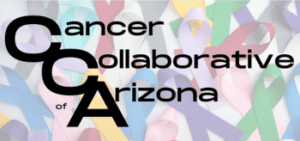 Last month, Bag It Cancer, as part of the Cancer Collaborative of Southern Arizona held an Open House for Healthcare Providers to share with them the numerous services and resources provided by nonprofit organizations in our community to help their patients. The providers who attended were very positive and excited to learn about all the programs available and gathered lots of resources they can share with their patients and their families.
Last month, Bag It Cancer, as part of the Cancer Collaborative of Southern Arizona held an Open House for Healthcare Providers to share with them the numerous services and resources provided by nonprofit organizations in our community to help their patients. The providers who attended were very positive and excited to learn about all the programs available and gathered lots of resources they can share with their patients and their families.
The purpose of the Cancer Collaborative of Arizona (CCA) is to provide a community supporting our common mission – providing resources and support for those dealing with the challenges of a cancer diagnosis.
How to Find Support Services and Programs Near You
- Ask your healthcare team if they offer support services and programs at their facility, or where you can find them locally.
- Check with other cancer medical providers in your area. Many serve all patients, no matter where they receive treatment.
- Contact the national offices of large cancer nonprofits to see if they have a local chapter in your area.
- Contact local nonprofits that offer programs for your type of cancer.
- Check with faith-based organizations, local libraries, community centers, and health departments.
- For seniors, reach out to your local Area Agency on Aging.
- Ask other people with cancer and their caregivers you meet along the way.
Explore Our Vetted Support Services List
There are many resources and organizations offering cancer information and all types of support for people diagnosed with cancer and those around them. But it can be tricky and take a lot of time to sort through them to find sources that are reliable, and have what you are looking for.
The vetted resource lists on the Resources document at right may have everything you need–or it is a good place to start if you prefer to do your own research. We’ve also added phone numbers if you prefer to call and speak to someone.

 As this year comes to a close, I find myself thinking about the many hands that have held a Bag It Bag, the conversations sparked by our resources, and the moments when someone realizes they are not facing cancer alone. Those stories stay with me. They remind me why this work matters—and how grateful I am for this community.
As this year comes to a close, I find myself thinking about the many hands that have held a Bag It Bag, the conversations sparked by our resources, and the moments when someone realizes they are not facing cancer alone. Those stories stay with me. They remind me why this work matters—and how grateful I am for this community.

 Cancer. It’s a word that can shake the foundation of a person’s world—whether it’s your own diagnosis or that of someone you love. The emotional weight is immense, and the journey ahead can feel uncertain and overwhelming. But one of the most powerful ways we can help is simple: we show up.
Cancer. It’s a word that can shake the foundation of a person’s world—whether it’s your own diagnosis or that of someone you love. The emotional weight is immense, and the journey ahead can feel uncertain and overwhelming. But one of the most powerful ways we can help is simple: we show up. Showing up also means keeping life going. Talk to them about your day, share funny stories, laugh about your kids or grandkids—just like you always did. These moments of normalcy can be grounding and comforting.
Showing up also means keeping life going. Talk to them about your day, share funny stories, laugh about your kids or grandkids—just like you always did. These moments of normalcy can be grounding and comforting.
 September 21 marks Take a Loved One to the Doctor Day—a national reminder that good health isn’t just a personal responsibility; it’s an important way we can support each other.
September 21 marks Take a Loved One to the Doctor Day—a national reminder that good health isn’t just a personal responsibility; it’s an important way we can support each other. How You Can Participate
How You Can Participate



 Last month, Bag It Cancer, as part of the Cancer Collaborative of Southern Arizona held an Open House for Healthcare Providers to share with them the numerous services and resources provided by nonprofit organizations in our community to help their patients. The providers who attended were very positive and excited to learn about all the programs available and gathered lots of resources they can share with their patients and their families.
Last month, Bag It Cancer, as part of the Cancer Collaborative of Southern Arizona held an Open House for Healthcare Providers to share with them the numerous services and resources provided by nonprofit organizations in our community to help their patients. The providers who attended were very positive and excited to learn about all the programs available and gathered lots of resources they can share with their patients and their families.
Recent Comments